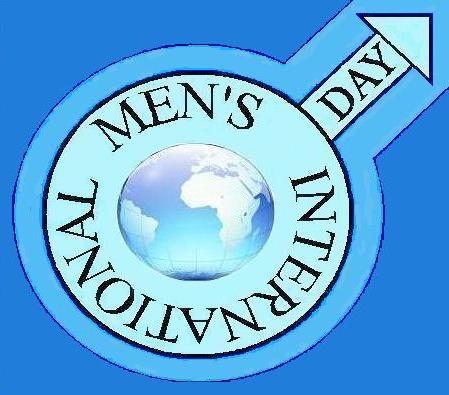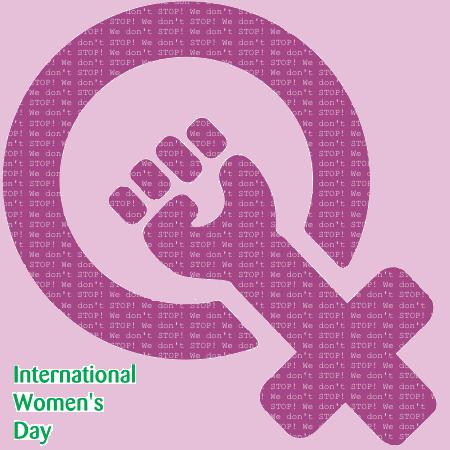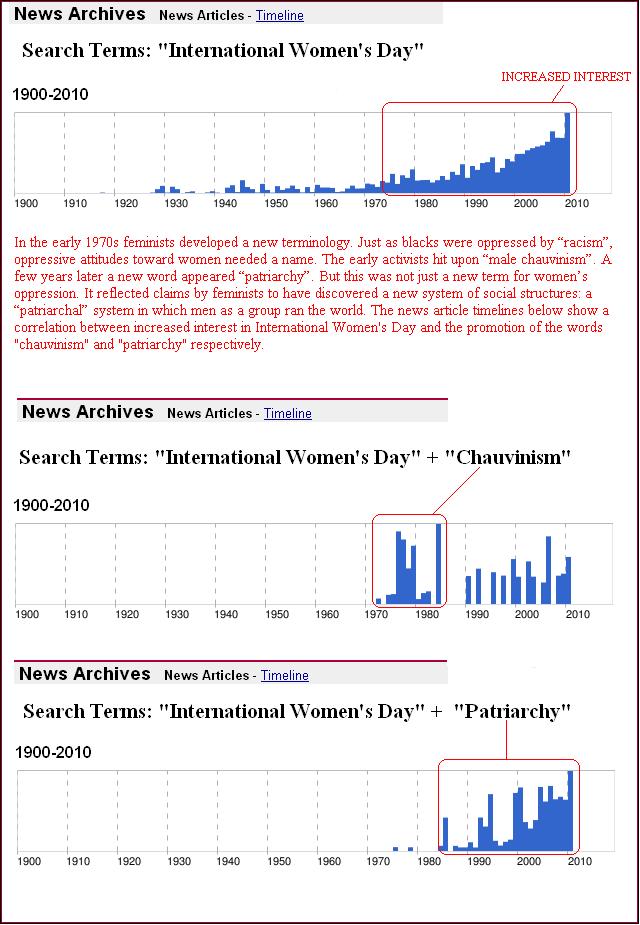Origins and Evolution: Perspectives of two International Days
By Jason Thompson - 2010

By Jason Thompson - 2010


The observation of International Men’s and Women’s days involve numerous objectives, with both days highlighting issues considered unique to men or women. The following is not to be read as a comprehensive overview of both days but rather an attempt to highlight two central and rather different currents of IWD and IMD; women’s fight against oppression, and men’s attempts to promote positive male role models.
There are several popular myths about the origins of International Women’s Day and after a survey of the current literature it seems the variety of accounts have created confusion for commentators. For example, a widely bruited falsehood about IWD which surfaced in French Communist circles claimed women from clothing and textile factories had staged a protest on 8 March 1857 in New York City. This story alleged that garment workers were protesting against very poor working conditions and low wages and were attacked and dispersed by police. It was claimed that this event led to a rally in commemoration of its fiftieth anniversary in 1907, with this gathering constituting the very first IWD. In response to these claims Temma Kaplan explains that “Neither event seems to have taken place, but many Europeans think March 8, 1907 inaugurated International Women's Day.” 1 Speculating about the origins of this 1857 legend Liliane Kandel and Françoise Picq suggested it was likely that (in recent times) some felt it opportune to detach International Women's Day from its basis in Soviet history and ascribe to it a more 'international' origin which could be painted as more ancient than Bolshevism and more spontaneous than a decision of Congress or the initiative of those women affiliated to the Party. 2
Whilst numerous apocryphal stories of this nature exist, we can safely say that International Women’s Day was first initiated by German socialist Clara Zetkin in 1910 as a way to promote socialist political objectives and was always referred to by the political name ‘International Working Women’s Day’. Observation of the event was primarily restricted to the Soviet bloc. It wasn’t until the 1970s when women outside of the Soviet bloc looked to celebrating the event that the word ‘working’ was increasingly omitted along with much of it’s socialist meaning.
Beginning in the 1970’s IWD became subject to a feminist revisioning. Whereas IWWD was previously used to highlight working women’s oppression by a bourgeois and powerful upper class of both men and women, 1970s feminists revisioned the basis of the day by stating that it was now men alone as a class of “chauvinists” who wielded all power over all women who had each become victims of men’s domination. It was men’s oppressive rule which IWD must now focus on overthrowing. With this new ideological turn women were no longer viewed as part of the privileged upper class, and those former oppressors of women- i.e. capitalism; traditional gender schemas imposed by powerful men and women; various laws, language and so on- were reduced to one all-encompassing enemy: males and their patriarchal belief system. This new ideological basis for IWD was elaborated in the late 1970s-80s under the label “patriarchy theory”3 and it’s arrival correlated with a sharp increase in the numbers of women observing IWD,4 an interest no doubt generated by heightened concerns or fears over ‘patriarchal oppression’ of women. It is certainly true that women have been oppressed and are still oppressed by gender stereotypes and power structures (as are men), and the fight for liberation is a legitimate and necessary undertaking. Nevertheless in light of what appear to be oversimplified explanations proposed by ‘patriarchy theory’5 one hopes that the causes of oppression continue to be explored in more sophisticated and nuanced ways to give International Women’s and Men’s Day’s credible platforms for promoting gender equality and improving gender relations.
International Men’s Day, as conceived by Dr. Jerome Teelucksingh in 1999, has a completely different origin and ideological basis to both the early and later phases of International Women’s Day. Although the objectives of IMD occasionally intersect with those of IWD, such as advocating equality between the sexes, it is primarily concerned with celebrating positive male role models and other issues unique to men’s and boys experiences. This approach is deemed necessary in a social context which is often fascinated with images of males behaving badly, eg. media portrayals of males as stupid, emotionless, greedy, violent, dangerous, power-hungry, selfish, irresponsible and so on. Such negative male stereotypes are frequently promoted in an attempt to shame males into behaving more positively, ignoring the fact that the negative behaviours may not apply to the vast majority of men and boys, or that such negativity may detrimentally impact the self-image and self-esteem of boys, which in turn impacts their willingness to contribute to building better relationships and communities. In highlighting positive male role models IMD attempts to show that males of all ages respond much more energetically to positive role models than they do to negative stereotyping.
In summary, International Women’s Day started as a day for women to promote socialist objectives, especially for proletarian women to fight against oppression by the powerful upper classes comprised of men and women both. In the 1970’s it became a new movement claiming that men alone oppressed women, and that IWD will be used as a vehicle to highlight, primarily, the results of an assumed gender war. Said differently the focus of IWD shifted from a class war, to a gender war.
International Men’s Day is not based on the assumption of a gender war. IMD is primarily about promoting and celebrating positive male role models in a contemporary world context which seems fixated with teaching all young boys and girls that males behave badly, and only badly.
References
[1] Temma Kaplan, On the Socialist Origins of International Women's Day, in: Feminist Studies, 11, 1985, S. 163-171. (PDF)
[2] Liliane Kandel / Françoise Picq, Le Mythe des origines à propos de la journée internationale des femmes, in: La Revue d'en face, 12, 1982, S. 67-80.
[3] Lindsey German, Theories of Patriarchy in International Socialism second series no 12. 1981. ( DOC)
[4] 1900-2010: Increased interest in IWD correlates with the emergence of ‘patriarchy theory’.

[5] Sandra Bloodworth, The Poverty of Patriarchy Theory Originally published in Socialist Review (Australian), Issue 2, Winter 1990, pp. 5-33. ( DOC)
ΠΗΓΗ: